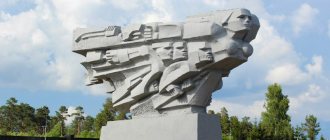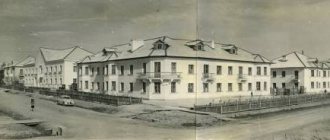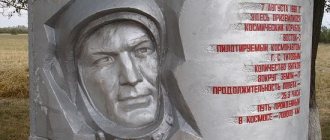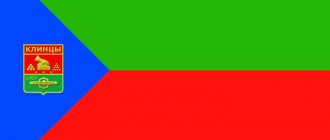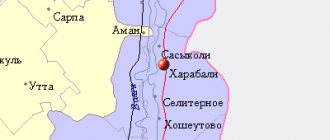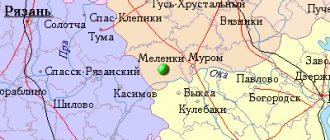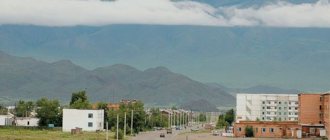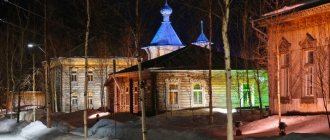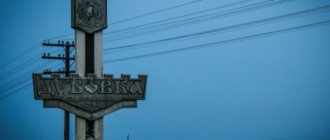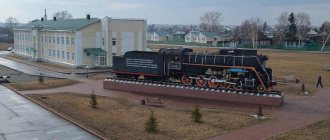This term has other meanings, see Agidel (meanings).
| City | |
| Agidel | |
| head Aғiҙel | |
| Flag | Coat of arms |
Moscow
Ufa
Agidel
Media files on Wikimedia CommonsDesign of street names in Agidel - in Russian and Bashkir languages
Agidel
(Bashk. Aғiҙel listen) is a city (since 1991) in the Republic of Bashkortostan of Russia.
A city of republican significance, it forms the urban district of the city of Agidel
[3].
Story
It emerged as a village in June 1980 in connection with the construction of the Bashkir Nuclear Power Plant, and since 1991 it has had the status of a city[5]. To meet the needs of the nuclear power plant under construction, 2 military units 455 and 748 VSO 171 of the Directorate of Military Construction Units of the PRiUVO were redeployed to the village. The units were merged into one military unit number 455 VSO in 1990. In 1990, the military unit was transferred to the city of Kovrov and disbanded. [ source not specified 1086 days
]
In 1990, under pressure from the green forces, the construction of the nuclear power plant in Agidel was stopped, as a result of which many local residents lost their jobs. On September 2, 1993, Decree of the Presidium of the Supreme Council of Bashkortostan No. 6-2/408 “On measures to stimulate jobs in the city of Agidel” was adopted, which largely ensured the viability of the city[6].
Population
| ↗19 600 | ↗20 000 | ↘19 800 | →19 800 | ↘18 721 | ↘18 700 | ↗18 900 | →18 900 | |
| 2007[8] | 2008[10] | 2009[11] | 2010[12] | 2011[8] | 2012[13] | 2013[14] | 2014[15] | 2015[16] |
| →18 900 | ↗18 992 | ↗19 139 | ↘16 370 | ↗16 400 | ↘16 123 | ↘15 932 | ↘15 865 | ↘15 749 |
| 2016[17] | 2017[18] | 2018[19] | 2019[20] | 2020[2] | ||||
| ↘15 616 | ↘15 281 | ↘14 959 | ↘14 601 | ↘14 219 |
As of January 1, 2022, in terms of population, the city was in 810th place out of 1116[21]cities of the Russian Federation[22].
According to the forecast of the Russian Ministry of Economic Development, the population will be[23]:
- 2024 - 13.94 thousand people.
- 2035 - 11.36 thousand people.
National composition
According to the 2010 All-Russian Population Census: Tatars - 53.6%, Bashkirs - 22.2%, Russians - 16.2%, Maris - 4.3%, Udmurts - 1.5%, persons of other nationalities - 2, 2%[24].
Local government
The structure of local government bodies of the urban district is [3]:
- the representative body of the urban district, called the Council;
- the head of the city district, called the Chairman of the Council;
- administration of the city district, called the Administration.
Chairman of the City District Council of the city of Agidel
[25]: Sineva Rasima Akhsanovna;
Head of the Administration of the urban district of the city of Agidel
[26]: Gilvanov Fanis Yafasovich.
Links
- [02.xn--b1aew.xn--p1ai/news/item/8302200 police detained the head of the Agidel city administration] - Press service of the Ministry of Internal Affairs for the Republic of Bashkortostan
Shut down nuclear power plants Aktau (former Shevchenko) • Visaginas (former Snechkus) • Obninsk • Pripyat (abandoned in 1986) • Seversk (former Tomsk-7) • Slavutich Unfinished nuclear power plants Agidel • Orbit • Kamskie Polyany • Teplodar • Chistye Bory • Shchelkino
Transport
100 km from the city is the Yanaul railway station of the Gorky Railway, located on the Moscow-Ekaterinburg highway. The nearest railway station Neftekamsk is 50 km from the city[27]. There is a departmental railway station in Agidel without passenger traffic.
The Neftekamsk-Dyurtyuli regional highway runs 20 km east of the city.
The pier, now abandoned. Through the Belaya and Kama rivers, Agidel has access to the Caspian, Black and Baltic seas; it is possible to receive river-sea vessels with a displacement of up to 5,000 tons.
History of the city of Agidel
Agidel is a city in the north-west of the Republic of Bashkortostan, located on the right bank of the lower reaches of the Belaya River. It emerged as a village in 1980 in connection with the construction of the Bashkir Nuclear Power Plant, and since 1991 it has had the status of a city. It is located 45 km from the city of Neftekamsk, 100 km from the Yanaul railway station.The city has convenient transport links. It is connected by a 50 km long railway line to the Amzya station, located on the Kazan-Ekaterinburg railway of the Gorky Railway. 20 km east of the city there is a third technical category highway with asphalt concrete pavement, connecting the city with Ufa, Izhevsk, Kazan, Perm, and Yekaterinburg. Through the Belaya and Kama rivers, Agidel has access to the Caspian, Black, and Baltic seas, and has the ability to host river-sea vessels with a displacement of up to 3000-5000 tons.
There are 3 schools in the city: secondary schools No. 1, No. 2, a gymnasium and the Ufa Fuel and Energy College.
The population of the city is 20.4 thousand people. The working population is 12 thousand people, and those under working age are 7 thousand people.
The average age of city residents is 29 years.
Among them, representatives of 17 nationalities coexist peacefully. The most numerous national diasporas are Bashkir, Tatar and Russian. The Finno-Ugric peoples in Agidel are represented by the Mari, Udmurts, and Mordovians. Among the Agidelians there are Ukrainians, Belarusians, Chuvashs, Germans, Latvians, Jews, Georgians, Ossetians, Komi-Permyaks and other nationalities.
...Here, where the Belaya and Kama rivers merge, in 1980 a satellite city of the Bashkir nuclear power plant was founded with the poetic name - Agidel (translated from Bashkir - White). Builders and nuclear power engineers came here from all over the country, preparing to devote themselves to the construction and subsequent operation of the energy giant, as well as to take part in the construction of residential areas of the city designed by Moscow architects.
Flipping through the pages of Agidel’s 25-year biography, one involuntarily asks the question: how did the pioneer builders of the city and the Bashkir nuclear power plant manage to resist incredible difficulties? It all started with tents, wooden barracks, multi-family communal apartments... No school, no hospital, no canteen... There wasn’t even a normal access road! It was a stormy outburst of mass enthusiasm - work did not stop for days, production buildings grew before our eyes and, at the same time, beautiful multi-storey buildings. The first ten years were permeated with the enthusiasm of the builders of the Bashkir NPP, their desire to carry out the assigned work at a high professional level. The village grew, a unique construction and installation base developed, highly qualified specialists worked, but... The second stage began. Impressed by the consequences of the accident at the Chernobyl nuclear power plant in 1990, the construction of the Bashkir nuclear power plant was stopped. For several years the city lived by inertia, fighting for every day of its existence... Today there is no point in telling in detail about the dramatic page inscribed in the history of Agidel by the elements of the “green movement”. In 1990, the construction of the Bashkir Nuclear Power Plant was stopped, more than 500 million rubles remained “buried” at the power plant construction site, thousands of highly qualified specialists found themselves without a means of subsistence. The problem of their employment has risen to the fore. Moreover, initially not having a single industrial enterprise other than the bankrupt Construction Administration of the Bashkir Nuclear Power Plant, Agidel found herself without a tax base.
The dissatisfaction of city residents with forced unemployment increased every day. In this situation, deputies of the Agidel City Council decide to appeal to the President of the Republic of Bashkortostan with a proposal to introduce a preferential tax regime in the city for enterprises that create new jobs. The appeal of the deputies marked the beginning of a large and painstaking work to create an economically favored zone in Agidel. The working group prepared all the necessary materials, and on July 4, 1996, the President of the Republic of Bashkortostan signed Decree No. UP-358 “On the creation of the economically favored zone “Agidel”. Successfully implementing the city program to support small businesses, the Agidel administration contributed to the creation of many manufacturing enterprises in the city that are successfully operating today. Among them: Agidel-M LLC (modern cabinet office and household furniture); OJSC "Bashatomterminal" (construction and operation of port facilities); LLC "Teplostim" (introduction of energy-saving technologies, housing and communal services (licensed transportation of goods in Russia, including transportation on specialized vehicles); LLC "Esna" (construction and installation of power lines and substations, electrical installation and commissioning work on the protection systems of boiler inspection facilities, repair of measuring instruments); LLC "Agidelstroyservis" (construction, installation and repair work, motor transport services, auxiliary construction products) and others. Work of Agidel enterprises operating under economically favorable conditions , had a positive impact on the growth of industrial production and increased investment activity in fixed capital. It was this fact that allowed the city to successfully reconstruct the sand-lime brick plant with a production capacity of 50 million bricks per year and begin preparations for organizing the production of cellular concrete. The investment activity of the enterprise is no less significant for the production of cabinet furniture "Agidel-M", where in 2004 the second production line, fully equipped with Italian equipment, was put into operation. Another facility that is part of the core of Agidel’s production potential is the first stage of the river cargo port - the dark oil products terminal. Currently, preparations are underway for the construction of the second stage of port facilities - a dry cargo terminal. Having entered into operation at full production capacity, the Agidel cargo port will open up new prospects for the development of the economy not only of the city, but also of the republic.
...The most difficult years are behind us. The third stage in the biography of the city is encouraging. Today Agidel has a well-developed social infrastructure. More than 90% of the apartments of Agidel residents are equipped with telephones, mobile communications are stable, and the most popular programs among the population of Agidel are broadcast via intra-city television cable at a fairly high technical level. All residential buildings are provided with uninterrupted water supply; heat and hot water are supplied to the apartments from a central boiler house, on the basis of which two gas turbine units are installed.
The city has a multidisciplinary hospital, equipped with the most modern medical equipment and considered one of the best in Bashkiria; two secondary schools, a Bashkir gymnasium, a vocational lyceum, and a branch of the Ufa Fuel and Energy College are well equipped; there is a House of Culture, an art school, a children's and youth sports school, etc. The population of the city supports two religious denominations: Islam and Orthodoxy. Agidel’s amateur artistic groups are known far beyond the borders of Bashkortostan. Students of the art school became laureates and diploma winners of Russian and international competitions. The city's athletes have repeatedly won prizes in republican and Russian competitions.
The city of Agidel has been repeatedly named among the winners of republican competitions for the development of small business, healthcare, culture and sports. Agidel is rightfully recognized as one of the most comfortable cities in Bashkortostan in its group, and in 2004, following the results of the All-Russian competition for the title “The most comfortable city in Russia,” the city administration was awarded an Honorary Diploma of the Ministry of Industry and Energy of the Russian Federation.
While supporting and developing the city, the leadership of the republic and Agidel do not forget about the main thing: Agidel is a city of nuclear scientists. Nuclear energy is the future, and the real prospect of our city is to become the center of nuclear energy in the region. For this, Agidel has everything necessary, since in the most difficult years for us we managed to maintain our production and spiritual potential. Today, preparatory work is being systematically carried out. The nuclear power plant can be located on the previous, comprehensively researched and developed site, which received the highest assessment at the level of the government of the Russian Federation and the Energoatom concern. But while waiting for the resumption of construction of the Bashkir Nuclear Power Plant, Agidel residents are not sitting idly by. As before, local authorities are taking all possible measures within the limits of current legislation to maintain a favorable climate for the further development of private entrepreneurship in the city. Small business, of course, is not a panacea for all evils; one cannot do without Agidel’s city-forming enterprise, but for now it remains the only real source of budget replenishment, guaranteeing the well-being of the city and its residents.
...This is how, step by step, the city administration solves vital problems, of which there are still many in Agidel. And what is characteristic is that they are not hidden from the population, the true state of affairs is not simplified or embellished. On the contrary, all the most important issues are put up for public discussion so that every city resident, regardless of his social and financial situation, knows the essence of the problems being solved by the city leadership, thinks about them, and takes part in solving them to the best of his ability.
On his initiative and with the support of Council deputies, the money saved from the introduction of energy-saving technologies is invested in the development of healthcare, education, culture, and sports. In preparation for the resumption of construction of the nuclear power plant, the city administration is paying close attention to the younger generation of Agidel residents. Agidel is not only the youngest, but also the most youthful city in Bashkiria. It is the children and grandchildren of the local pioneers who will have to complete the construction of the nuclear power plant and its satellite city. But today only fully developed, well-trained professionals in their field can be in demand on the labor market. Therefore, the city’s teachers are trying to steadily improve the level of general training of Agidel schoolchildren from year to year. The results are obvious: many graduates successfully pass entrance exams to the most prestigious universities in the country, and the management of the Obninsk Technical University has even sent an on-site admissions committee to Agidel for several years now, with no doubt that future nuclear scientists will find worthy use of the knowledge gained at the Bashkir Nuclear Power Plant and other energy plants enterprises in Russia.
…Cities are like people: they are born, grow, become stronger, and set out on an independent path of life. But, like people, they need fatherly care, support, and help in difficult times. Agidel is no exception. What the city looks like today - well-groomed on the outside and filled with all the blessings of everyday life on the inside, confident in its future - is the result of tireless care for it on the part of the leadership of the republic, local authorities, and the residents themselves.
Yes, Agidel is a small town according to the canons of statistics. But he is great for his noble creative work. In summer and autumn, Agidel is especially beautiful - all in flowers, green alleys and squares. And in every flower one sees a reflection of the confidence of the Agidel people that if they wish and are aware of the rightness of their cause, they can achieve a lot, overcoming all difficulties and adversity with honor.
Agidel residents have no doubt that the production potential of the Bashkir NPP construction site, preserved through their efforts, will definitely be in demand by the country’s leadership.
source: adm-agidel.info
Attractions
- Rosenergoatom building. The city of Agidel was designed and then built as a city serving the nuclear power plant. Construction began in 1980 with global preparation of the territory for the nuclear power plant and the settlement itself. In 1986, the Chernobyl accident influenced the decision to continue construction of the reactor. The three-story building, now the Rosenergoatom building, was the main task from where Midhat Akhmetovich Shakirov managed the entire difficult situation. Today, the Rosatom building houses several social services and Rosatom representatives. At the entrance there is an information board telling about nuclear energy in the world and Russia. On the shield you can see how many nuclear power plants there are; the infographic shows how many units are currently operating at a particular station in Russia (2015 data)[28].
Sign on the Rosenergoatom building, Midhat Akhmetovich Shakirov[28]
- Light fountain. An original, crowd-pleasing composition with flowing streams of light, different color shades, accompanied by music. The area around it represents a holistic composition; there is a recreation area and a children's playground. The entire site is arranged around a circle of light balls. During the daytime, the light balls have a matte white color and look more like bowling balls[29].
Light fountain in Agidel[28]
- Nur Mosque. The mosque was built in 2003. A small brick building with a minaret stands in a secluded place, a little away from the residential area. The territory of the mosque is surrounded by a small garden, trees are planted here, and flower beds are laid out. A brick fence separates the mosque area from the park, creating the feeling of a separate world of prayer. From October to April, a madrasah operates at the Nur Mosque, where classes are held to study Arabic literacy and the fundamentals of the Islamic religion. Friday prayers are performed here, naming and nikah (marriage) rituals are held. The entrance to the prayer hall itself is on the right side. The left door will lead to a shop, here you can buy items for rituals, women's hats are presented in an assortment. The decoration inside “Nur” is traditional; the small room is illuminated by many windows, pentagonal in shape, with sharp corners in the upper part. They echo the general geometric shape of the entire building, the walls of which have five sharp corners. A large number of windows create an incredibly bright room inside. The mihrab, a semicircular niche facing Mecca, is located here between two windows in a pointed niche of the building. The name of the mosque “Nur”, which means light, ray, could not be more accurately correlated with the incredibly bright interior[30].
Nur Mosque in Agidel[28]
- Church of Spyridon of Trimifuntsky. The church and the complex of buildings consist of two bell towers, a gate, and a fenced area. There are flower beds around the temple and a bench for parishioners. The temple, named in the name of St. Spyridon of Trimifuntsky, a miracle worker, appeared on the initiative of a student at the Ufa Aviation Institute, Dmitry Shurupov, who wrote a letter to Bishop Nikon of Ufa and Sterlitamak asking about the possibility of organizing an Orthodox church in the city of Agidel. The answer was positive, and in 1997 the creation of a parish for Orthodox Christians began. In 1998, the Agidel Orthodox parish was officially registered and, with the blessing of Vladyka Nikon, received the right to be called a church in the name of St. Spyridon of Trimythous, the miracle worker[31].
Church of Spyridon Trimifuntsky[28]
- Sports and leisure center and health path[32].
- Museum of History and Local Lore. Several halls with exhibitions tell visitors not only about the 40-year history of the city, but also the history of the peoples inhabiting the lands of the region[33].
Museum of History and Local Lore in the city of Agidel[28]
- Victory Park. “Eternal memory to home front workers” is the inscription on the right side of the memorial. The figure of a soldier with a machine gun is placed on the left side, behind his back is the inscription: “Eternal glory to the children of war.” On the territory of Victory Park in the city there is another important memorial “Participants in the liquidation of the Chernobyl nuclear power plant accident”[34].
Victory Park in Agidel[28]
- “Safe Haven”[35].
- Park of the city of Agidel[36].
- Unfinished nuclear power plant in Agidel[37].
- City Victory Square with 60 blue spruce trees (2005).
- Wall of memory with metal plaques on which are written the names of those killed in the Great Patriotic War (109 names in total)
- Granite slab in memory of soldiers who performed their sacred duty (2014).
- Monument to Kholban Ruslan Konstantinovich (1981-2009), captain, employee of department “A” of the FSB of Russia. R.K. Kholban died in 2009 while performing a special mission in the Republic of Dagestan[38].
Excerpt characterizing Agidel
- A! “He’s alive,” said Napoleon. – Raise this young man, ce jeune homme, and take him to the dressing station! Having said this, Napoleon rode further towards Marshal Lan, who, taking off his hat, smiling and congratulating him on his victory, drove up to the emperor. Prince Andrei did not remember anything further: he lost consciousness from the terrible pain that was caused to him by being placed on a stretcher, jolts while moving, and probing the wound at the dressing station. He woke up only at the end of the day, when he was united with other Russian wounded and captured officers and carried to the hospital. During this movement he felt somewhat fresher and could look around and even speak. The first words he heard when he woke up were the words of the French escort officer, who hurriedly said: “We must stop here: the emperor will pass by now; it will give him pleasure to see these captive gentlemen. “There are so many prisoners these days, almost the entire Russian army, that he probably got bored with it,” said another officer. - Well, however! This one, they say, is the commander of the entire guard of Emperor Alexander,” said the first, pointing to a wounded Russian officer in a white cavalry uniform. Bolkonsky recognized Prince Repnin, whom he had met in St. Petersburg society. Next to him stood another, 19-year-old boy, also a wounded cavalry officer. Bonaparte, galloping up, stopped his horse. -Who is the eldest? - he said when he saw the prisoners. They named the colonel, Prince Repnin. – Are you the commander of the cavalry regiment of Emperor Alexander? - asked Napoleon. “I commanded a squadron,” answered Repnin. “Your regiment honestly fulfilled its duty,” said Napoleon. “The praise of a great commander is the best reward for a soldier,” said Repnin. “I give it to you with pleasure,” said Napoleon. -Who is this young man next to you? Prince Repnin named Lieutenant Sukhtelen. Looking at him, Napoleon said, smiling: “II est venu bien jeune se frotter a nous.” [He came young to compete with us.] “Youth doesn’t stop you from being brave,” Sukhtelen said in a breaking voice. “Excellent answer,” said Napoleon. - Young man, you will go far! Prince Andrei, who, to complete the trophy of the captives, was also put forward, in full view of the emperor, could not help but attract his attention. Napoleon apparently remembered that he had seen him on the field and, addressing him, used the same name of the young man - jeune homme, under which Bolkonsky was reflected in his memory for the first time. – Et vous, jeune homme? Well, what about you, young man? - he turned to him, - how do you feel, mon brave? Despite the fact that five minutes before this, Prince Andrei could say a few words to the soldiers carrying him, he now, directly fixing his eyes on Napoleon, was silent... All the interests that occupied Napoleon seemed so insignificant to him at that moment, so petty seemed to him his hero himself, with this petty vanity and joy of victory, in comparison with that high, fair and kind sky that he saw and understood - that he could not answer him. And everything seemed so useless and insignificant in comparison with the strict and majestic structure of thought that was caused in him by the weakening of his strength from the bleeding, suffering and the imminent expectation of death. Looking into the eyes of Napoleon, Prince Andrei thought about the insignificance of greatness, about the insignificance of life, the meaning of which no one could understand, and about the even greater insignificance of death, the meaning of which no one living could understand and explain. The emperor, without waiting for an answer, turned away and, driving away, turned to one of the commanders: “Let them take care of these gentlemen and take them to my bivouac; let my doctor Larrey examine their wounds. Goodbye, Prince Repnin,” and he, moving his horse, galloped on. There was a radiance of self-satisfaction and happiness on his face. The soldiers who brought Prince Andrei and removed from him the golden icon they found, hung on his brother by Princess Marya, seeing the kindness with which the emperor treated the prisoners, hastened to return the icon. Prince Andrei did not see who put it on again or how, but on his chest, above his uniform, suddenly there was an icon on a small gold chain. “It would be good,” thought Prince Andrei, looking at this icon, which his sister hung on him with such feeling and reverence, “it would be good if everything were as clear and simple as it seems to Princess Marya. How nice it would be to know where to look for help in this life and what to expect after it, there, beyond the grave! How happy and calm I would be if I could now say: Lord, have mercy on me!... But to whom will I say this? Either the power is indefinite, incomprehensible, which I not only cannot address, but which I cannot express in words - the great all or nothing, - he said to himself, - or this is the God who is sewn up here, in this palm, Princess Marya? Nothing, nothing is true, except the insignificance of everything that is clear to me, and the greatness of something incomprehensible, but most important! The stretcher started moving. With each push he again felt unbearable pain; the feverish state intensified, and he began to become delirious. Those dreams of his father, wife, sister and future son and the tenderness that he experienced on the night before the battle, the figure of the small, insignificant Napoleon and the high sky above all this, formed the main basis of his feverish ideas. A quiet life and calm family happiness in Bald Mountains seemed to him. He was already enjoying this happiness when suddenly little Napoleon appeared with his indifferent, limited and happy look at the misfortune of others, and doubts and torment began, and only the sky promised peace. By morning, all the dreams mixed up and merged into the chaos and darkness of unconsciousness and oblivion, which, in the opinion of Larrey himself, Doctor Napoleon, were much more likely to be resolved by death than by recovery.
Notes
- Republic of Bashkortostan. Total land area of the municipality
- ↑ 12
Population of the Russian Federation by municipalities as of January 1, 2022 (Russian). Date accessed: October 17, 2022. Archived October 17, 2022. - ↑ 1 2
Charter of the urban district of Agidel of the Republic of Bashkortostan - Pospelov, 2008, p. 69.
- Great Russian Encyclopedia: In 30 volumes / Chairman of scientific editor. Council Yu. S. Osipov. Rep. edited by S. L. Kravets. T. 1. A - Questioning. - M.: Great Russian Encyclopedia, 2005. - 766 p.: ill.: map.
- Recent history - Agidel - 450 years as part of Russia (undefined)
. Archived from the original on October 14, 2013. - All-Union population census of 1989. Urban population (undefined)
. Archived from the original on August 22, 2011. - ↑ 1 2 3 4 5 6 7 8 9
People's encyclopedia “My City”.
Agidel (undefined)
. Retrieved October 8, 2013. Archived October 9, 2013. - All-Russian population census 2002. Volume. 1, table 4. Population of Russia, federal districts, constituent entities of the Russian Federation, districts, urban settlements, rural settlements - regional centers and rural settlements with a population of 3 thousand or more (unspecified)
. Archived from the original on February 3, 2012. - 1.5. Population of the Republic of Bashkortostan by municipalities as of January 1, 2009
- The size of the permanent population of the Russian Federation by cities, urban-type settlements and regions as of January 1, 2009 (unspecified)
. Retrieved January 2, 2014. Archived January 2, 2014. - All-Russian population census 2010. Population by settlements of the Republic of Bashkortostan (unspecified)
. Retrieved August 20, 2014. Archived August 20, 2014. - Population of the Russian Federation by municipalities. Table 35. Estimated resident population as of January 1, 2012 (unspecified)
. Retrieved May 31, 2014. Archived May 31, 2014. - Population of the Russian Federation by municipalities as of January 1, 2013. - M.: Federal State Statistics Service Rosstat, 2013. - 528 p. (Table 33. Population of urban districts, municipal districts, urban and rural settlements, urban settlements, rural settlements) (undefined)
. Retrieved November 16, 2013. Archived November 16, 2013. - Table 33. Population of the Russian Federation by municipalities as of January 1, 2014 (unspecified)
. Access date: August 2, 2014. Archived August 2, 2014. - Population of the Russian Federation by municipalities as of January 1, 2015 (unspecified)
. Access date: August 6, 2015. Archived August 6, 2015. - Population of the Russian Federation by municipalities as of January 1, 2016 (Russian) (October 5, 2018). Retrieved May 15, 2022. Archived May 8, 2022.
- Population of the Russian Federation by municipalities as of January 1, 2022 (Russian) (July 31, 2017). Retrieved July 31, 2022. Archived July 31, 2022.
- Population of the Russian Federation by municipalities as of January 1, 2022 (Russian). Retrieved July 25, 2018. Archived July 26, 2022.
- Population of the Russian Federation by municipalities as of January 1, 2022 (Russian). Retrieved July 31, 2019. Archived May 2, 2022.
- taking into account the cities of Crimea
- https://rosstat.gov.ru/storage/mediabank/bul_Chislen_nasel_MO-01-01-2021.rar Population of the Russian Federation by municipalities as of January 1, 2022 (1.85 Mb, 07/30/2021)
- Spatial development strategy of the Russian Federation for the period until 2025 (draft)
- Results of the 2010 All-Russian Population Census for the Republic of Bashkortostan (unspecified)
. Archived March 9, 2013. - Structure of the City District Council of the city of Agidel
- Structure of the Administration of the urban district of the city of Agidel (undefined)
(inaccessible link -
history
). - “All electric trains of Russia”: Train schedule at Neftekamsk station (schedule 2008/2009) (unspecified)
. Archived from the original on September 17, 2010. - ↑ 1 2 3 4 5 6 7 Our Ural.
Rosenergoatom building in Agidel (Russian)
(undefined)
.
Our Ural
(November 3, 2021). Date accessed: December 29, 2022. - Our Ural.
Sights of Agidel: light fountain (Russian)
(undefined)
.
Our Ural
(November 2, 2021). Date accessed: December 29, 2022. - Our Ural.
Sights of Agidel: “Nur” mosque (Russian)
(undefined)
.
Our Ural
(October 29, 2021). Date accessed: December 29, 2022. - Our Ural.
Sights of Agidel: Church of Spyridon of Trimifunt (Russian)
(undefined)
.
Our Ural
(October 28, 2021). Date accessed: December 29, 2022. - Our Ural.
Agidel.
Sports and leisure center and health path (Russian) (undefined)
.
Our Ural
(October 28, 2021). Date accessed: December 29, 2022. - Our Ural.
Sights of Agidel: Museum of History and Local Lore (Russian)
(undefined)
.
Our Ural
(October 27, 2021). Date accessed: December 29, 2022. - Our Ural.
Victory Park in the city of Agidel (Russian)
(undefined)
.
Our Ural
(October 27, 2021). Date accessed: December 29, 2022. - Our Ural.
Sights of Agidel: “Quiet harbor” for recreation and fishing (Russian)
(undefined)
.
Our Ural
(October 25, 2021). Date accessed: December 29, 2022. - Our Ural.
Park of the city of Agidel (Russian)
(undefined)
.
Our Ural
(October 25, 2021). Date accessed: December 29, 2022. - Our Ural.
Sights of Agidel: nuclear power plant, where time stood still (Russian)
(undefined)
.
Our Ural
(August 5, 2021). Date accessed: December 29, 2022. - City of Agidel. Bashkir encyclopedia. (unspecified)
(inaccessible link). Retrieved September 15, 2022. Archived September 15, 2022.
